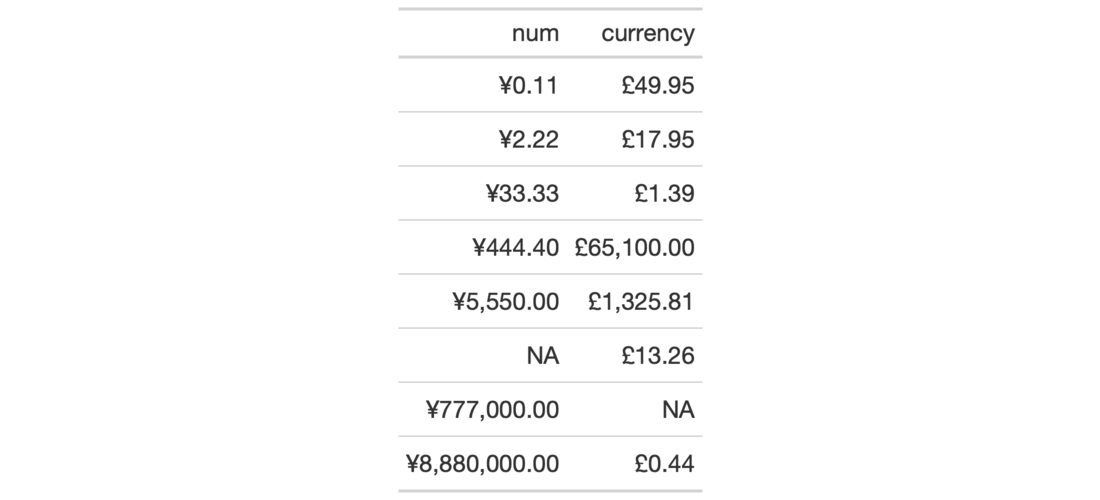With numeric values in a gt table, we can perform currency-based
formatting. This function supports both automatic formatting with a
three-letter or numeric currency code. We can also specify a custom currency
that is formatted according to the output context with the currency()
helper function. Numeric formatting facilitated through the use of a locale
ID. We have fine control over the conversion from numeric values to currency
values, where we could take advantage of the following options:
the currency: providing a currency code or common currency name will procure the correct currency symbol and number of currency subunits; we could also use the
currency()helper function to specify a custom currencycurrency symbol placement: the currency symbol can be placed before or after the values
decimals/subunits: choice of the number of decimal places, and a choice of the decimal symbol, and an option on whether to include or exclude the currency subunits (decimal portion)
negative values: choice of a negative sign or parentheses for values less than zero
digit grouping separators: options to enable/disable digit separators and provide a choice of separator symbol
scaling: we can choose to scale targeted values by a multiplier value
large-number suffixing: larger figures (thousands, millions, etc.) can be autoscaled and decorated with the appropriate suffixes
pattern: option to use a text pattern for decoration of the formatted currency values
locale-based formatting: providing a locale ID will result in currency formatting specific to the chosen locale
We can use the info_currencies() function for a useful reference on all of
the possible inputs to the currency argument.
fmt_currency( data, columns, rows = NULL, currency = "USD", use_subunits = TRUE, accounting = FALSE, decimals = NULL, use_seps = TRUE, scale_by = 1, suffixing = FALSE, pattern = "{x}", sep_mark = ",", dec_mark = ".", placement = "left", incl_space = FALSE, locale = NULL )
Arguments
| data | A table object that is created using the |
|---|---|
| columns | The columns to format. Can either be a series of column names
provided in |
| rows | Optional rows to format. Not providing any value results in all
rows in |
| currency | The currency to use for the numeric value. This input can be
supplied as a 3-letter currency code (e.g., We can also use the If nothing is provided to |
| use_subunits | An option for whether the subunits portion of a currency
value should be displayed. By default, this is |
| accounting | An option to use accounting style for currency values. With
|
| decimals | An option to specify the exact number of decimal places to
use. The default number of decimal places is |
| use_seps | An option to use digit group separators. The type of digit
group separator is set by |
| scale_by | A value to scale the input. The default is |
| suffixing | An option to scale and apply suffixes to larger numbers
(e.g., Including Any use of |
| pattern | A formatting pattern that allows for decoration of the
formatted value. The value itself is represented by |
| sep_mark | The mark to use as a separator between groups of digits
(e.g., using |
| dec_mark | The character to use as a decimal mark (e.g., using |
| placement | The placement of the currency symbol. This can be either be
|
| incl_space | An option for whether to include a space between the value and the currency symbol. The default is to not introduce a space character. |
| locale | An optional locale ID that can be used for formatting the value
according the locale's rules. Examples include |
Value
An object of class gt_tbl.
Details
Targeting of values is done through columns and additionally by rows (if
nothing is provided for rows then entire columns are selected). A number of
helper functions exist to make targeting more effective. Conditional
formatting is possible by providing a conditional expression to the rows
argument. See the Arguments section for more information on this.
Figures


Function ID
3-4
See also
Other Format Data:
data_color(),
fmt_datetime(),
fmt_date(),
fmt_markdown(),
fmt_missing(),
fmt_number(),
fmt_passthrough(),
fmt_percent(),
fmt_scientific(),
fmt_time(),
fmt(),
text_transform()
Examples
# Use `exibble` to create a gt table; # format the `currency` column to have # currency values in euros (EUR) tab_1 <- exibble %>% gt() %>% fmt_currency( columns = vars(currency), currency = "EUR" ) # Use `exibble` to create a gt table; # Keep only the `num` and `currency`, # columns, then, format those columns # using the "CNY" and "GBP" currencies tab_2 <- exibble %>% dplyr::select(num, currency) %>% gt() %>% fmt_currency( columns = vars(num), currency = "CNY" ) %>% fmt_currency( columns = vars(currency), currency = "GBP" )